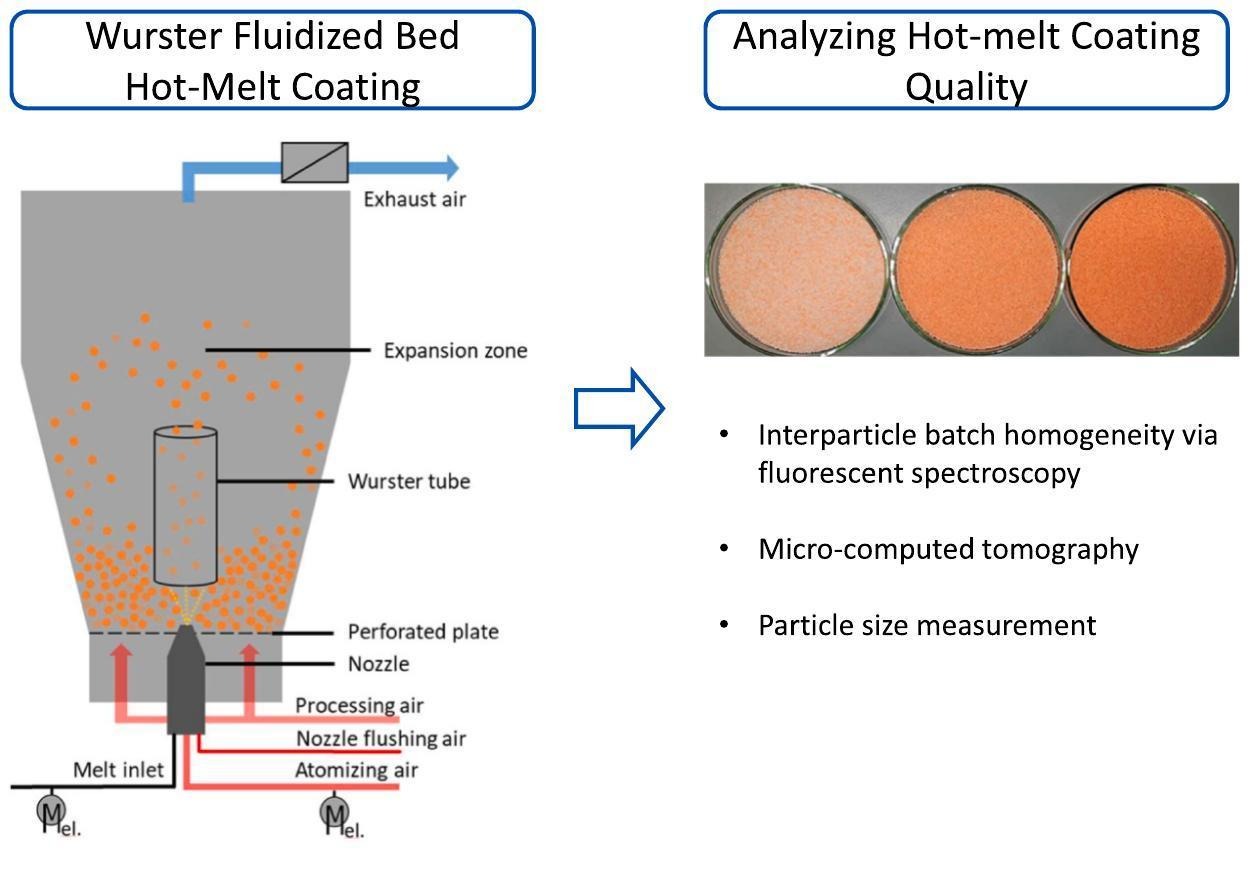Analyzing the interparticle batch homogeneity of natural hot-melt coatings

Abstract
The hot-melt coating process is widely used in the food and pharmaceutical industries. Its purpose of use is very diverse and includes, among other things, changing the functional properties of the particle surfaces, forming a protective layer or influencing the release rate of the encapsulated substance. To achieve such purposes for each product particle, a high degree of uniformity of coating of the single particles and a high interparticle batch homogeneity are required. However, such requirements are affected by multiple factors throughout the hot-melt coating process.
The main focus of this research is to evaluate the interparticle batch homogeneity, and to compare the results with alternative methods for coating quality analysis.
As a testing system, sugar spheres are coated with hydrogenated palm oil in a lab-scale Wurster fluidized bed. The coatings are investigated under various process conditions using particle size measurement and micro-computed tomography analysis. Additionally, a new method based on fluorescence spectroscopy is proposed to quantify interparticle batch homogeneity unaffected by structural phenomena such as delamination.
For the investigated test system, the results of this study show that a process temperature of 40 °C has the most favorable effect on the interparticle batch homogeneity, while spray rates between 3 and 20 g/min have only a minor influence.
Introduction
The coating process in a fluidized bed is widely used in the agricultural, chemical, food and pharmaceutical industries. The application objectives are wide-ranging, as the coating process can be used to influence surface properties or to protect sensitive ingredients from reactive environmental factors such as moisture, light or oxygen. In the food and pharmaceutical industries, for example, it is used for controlled release, taste masking, coloring or to improve handling by modifying flowability and dust prevention [1,2]. Due to the increasing demand for solids with functional properties and the growing quality requirements, the coating process is becoming increasingly important. In particular, the so-called hot-melt coating (HMC) with natural coating materials is increasingly coming into focus, as it meets the growing requirements for environmental sustainability and energy efficiency. Major coating materials for industrial HMC applications are hydrogenated vegetable oils (e.g. hydrogenated palm oil) and waxes, such as beeswax, carnauba wax or rice bran wax, due to their good moisture barrier [3,4]. The use of environmentally friendly and cost-effective raw materials gives a high innovation potential [1,5]. In HMC, the coating material is melted, sprayed onto and crystallized on the carrier particle. Compared to solvent-based coating, an energy-intensive drying step is not needed, allowing high spray rates with a fast coating build-up and a short process time. This, however, also limits the wetting and spreading process, which can lead to non-uniform layer structures. The coating provides the particle with a special functionality. The degree of functionality depends crucially on the quality of the coating layer. In particular, the benchmarks of intraparticle coating uniformity and interparticle batch homogeneity govern the quality and functionality of coatings. The coating structure should always be of uniform thickness, free of pores and cracks, and thus uniform [6]. Furthermore, to ensure consistent quality over all particles i.e. a high interparticle batch homogeneity with a low level of variation is desired [7]. Compliance with high quality requirements is very challenging in HMC and requires a high degree of knowledge about the process parameters and the coating material properties, especially for HMC of fine particles (> 100 μm). Consequently, understanding the influence of various parameters on the quality of the coated products is essential. Although the HMC process can be used for many applications, its potential use is still limited. The main reason for this is a lack of the fundamental understanding of the complex relationships between material properties and process parameters on the final product. Recent scientific studies are therefore following different directions in order to better understand this complex interplay.
Several studies have focused on the characterization of coating material properties that can affect final quality. Goslinka and Heinrich investigated the coating properties of natural waxes by determining their material properties such as water vapor permeability, thermal properties such as minimum film formation temperature, or surface roughness [8]. Especially beeswax and rice bran wax proved to be favorable as natural coating agents [8]. Lopes et al. studied the crystallization behavior as a function of the process temperature guidance of triacylglycerides, more specifically tristearin [9]. It was shown that the crystal form can be especially influenced by the process temperature control. Low process temperatures lead to unstable α-crystals, which in turn tend to recrystallize, resulting in a structural change of the coating layer morphology, which can subsequently decrease the interparticle batch homogeneity [9]. Post-coating tempering or the addition of additives to the coating material can help to promote polymorphic stabilization at lower temperatures [[9], [10], [11]]. Müller et al. influenced the complex thermal behavior of natural fats and waxes by specific blending without adding additives to achieve uniform coatings [12]. Meanwhile, Woerthmann et al. (2022) investigated the thermal wetting and delamination behavior of natural coating materials. Good wetting properties were shown, while differences in delamination behavior could be observed. Hydrogenated palm oil showed a higher tendency to delamination than waxes such as carnauba wax or rice bran wax [13]. A correlation between the choice of coating material and the resulting interparticle batch homogeneity in HMC was demonstrated [13,14].
Other studies, however, have focused specifically on process-influencing parameters or on novel analytical methods for analyzing the coating layer structure to better understand the complex relationships between coating quality and process conditions. The main process influencing factors are atomization pressure, fluidization velocity, spray rate, type of nozzle, plant geometry, process temperature, inlet air and hot-melt temperature [1,3,15]. The crucial quality characteristics of the coating layer can be the dissolution kinetics, mean layer thickness, non-coated surface proportion, the layer thickness distribution of a single particle, coating structures, and the interparticle batch homogeneity. For highly functional coatings, interparticle batch homogeneity together with intraparticle coating uniformity (i.e. uniform coating of a single particle) are of particular importance. Recently, studies have strongly focused on the systematic process understanding of the coating process. This can be achieved, for example, by experimental studies or by modeling and numerical simulations. The potential of numerical simulations for improving the understanding of the coating process is enormous. However, prediction accuracy depends on the accuracy of the experimental input data [16,17]. Dissolution tests and particle size analyses are popular and frequently used methods for evaluating coating success and quality. Release kinetics are particularly suitable for determining the protective effect of the coated product. However, no direct conclusions on interparticle batch homogeneity can be drawn from release kinetics of a particle collective, since the functionality and the protective effect in each case depend on both the uniformity of the coating within a particle and on the homogeneity of the particles among themselves [7,16]. Particle size analysis is also a standard method for proving coating success and calculating the mean coating layer thickness. However, particle size analyses are also limited in their validity and information content. For example, it is assumed that each particle is spherical, each size class grows uniformly, and an ideally uniform layer is formed on each particle without inclusions or delamination. Consequently, a comparison of the initial and coated particle size distribution allows only limited conclusions about the coating success and uniformity [18,19]. The method is therefore not suitable for the determination of interparticle batch homogeneity due to the numerous assumptions and dependency to structural phenomena such as delamination of the coating layer. Methods for determining coating thickness and interparticle batch homogeneity include confocal laser scanning microscopy (CLSM) [20,21], optical coherence tomography (OCT) [6,22,23], terahertz pulsed imaging (TPI) [24] or micro-computed tomography (μCT) measurements [25,26]. These methods allow the study of key characteristics providing information about the layer thickness distribution of single particles for a better systematic understanding of the process. Especially μCT measurements allow a detailed, high-resolution, non-destructive analysis of the surface, volume, or internal structures of materials in the field of particle technology [13,[27], [28], [29]]. For HMC, Woerthmann et al. (2021) developed a method to characterize the layer thickness uniformity and determine the uncoated surface fraction of single particles [26]. In another study, Woerthmann et al. (2022) used μCT measurements to show that material- and process-dependent delamination behavior in HMC can have a negative effect on interparticle batch homogeneity [13]. However, in addition to the large information density provided by μCT measurements of HMC particles, the disadvantages also became apparent. For example, the long measurement times, the large amount of data, and the costly and complicated measurement and analysis procedures are severely limiting. A significant number of samples for the investigation of interparticle batch homogeneity by means of μCT is therefore very difficult to implement or only with limited information content. Although there are many methods for characterizing coatings, there is still a lack of practical and cost-effective methods for investigating and identifying process parameters that influence the interparticle batch homogeneity of HMC. In contrast, an efficient, easy-to-perform measurement method with a high information content could be the investigation of batch homogeneity using an ancillary dye. Šibanc et al. investigated the interparticle batch homogeneity of solvent-based coatings by determining the amount of coating per particle via the measured tetrazine concentration in a UV/Vis spectrometer [30]. Following the method of Šibanc et al., the coating layer is dyed with a heat-stable fluorescent dye in order to quantify the coating amounts per particle via a fluorescence spectrophotometric measurement. By measuring the dye concentration per particle, the coating variability and the interparticle batch homogeneity will be determined afterwards.
The major motivation for this work is to better understand the coating variability of natural HMCs in a Wurster coater. This work is intended to enable a rapid non-hazardous and accurate analytical method to study the interparticle batch homogeneity of fine hot-melt coated particles, allowing conclusive interpretation of the data. Due to the frequent occurrence of delamination in natural hot-melt coated products, an additional objective is to obtain experimental data independent from structural phenomena. Furthermore, it will be shown that process-influencing variables on interparticle batch homogeneity can be identified. For an interpretation and discussion of the data, the experiments will be compared with common high-precision measurement methods and interpreted in a supplementary way. The process understanding will be extended by new knowledge about influencing variables of the coating variability in HMC, which will allow the data to be used for numerical simulations and modeling.
Materials
The experiments were performed using highly spherical (sphericity >0.93) sugar spheres (ρ25°C = 1541 kg/m3) (Pharm-a-Spheres GmbH, Germany). The particles have a relatively narrow size distribution with a mean particle size of d50,3 = 1140 μm with a standard deviation of σ = 75 μm. Hydrogenated palm oil (Kahlwax 6377) was used as natural coating material obtained from Kahl GmbH & Co. KG (Germany).
Read more here
B.M. Woerthmann, A. Hoffmann, J. Gerber, T. Wittkamp, H. Briesen, Analyzing the interparticle batch homogeneity of natural hot-melt coatings, Powder Technology, 2023, 118626, ISSN 0032-5910, https://doi.org/10.1016/j.powtec.2023.118626.
Read more on Shellac as a pharmaceutical excipient here:


